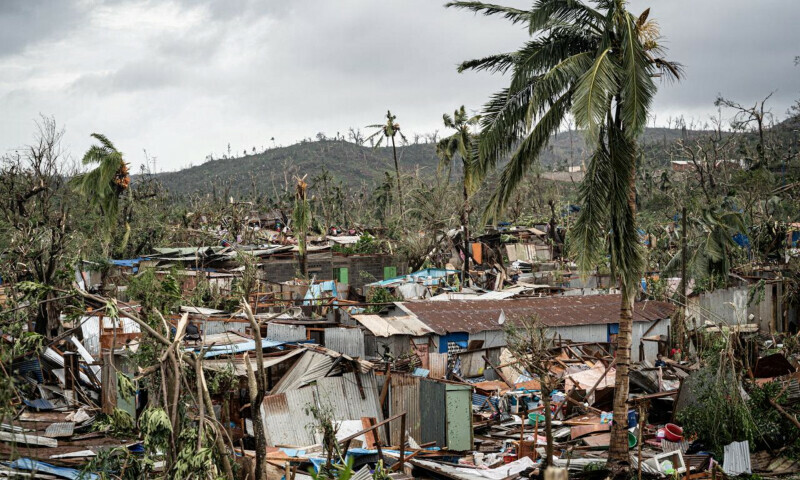A catastrophic cyclone has struck Mayotte Island, leaving hundreds feared dead and causing widespread devastation across the region. The island, located in the Indian Ocean, has been battered by strong winds, torrential rain, and flooding, resulting in significant damage to homes, infrastructure, and critical services. As the storm continues to wreak havoc, the death toll continues to rise, and emergency responders are working tirelessly to assist those affected.
Cyclone Hits Mayotte with Devastating Force
The cyclone, which made landfall over the weekend, intensified quickly and swept across the island with ferocious winds of over 200 km/h (124 mph). The storm’s arrival was preceded by warnings from meteorological authorities, but the sheer force of the cyclone has overwhelmed local preparedness efforts. In its wake, entire neighborhoods have been flattened, and vital infrastructure has been destroyed, making rescue operations even more challenging.
Reports from the island indicate that many people were caught off-guard by the storm’s intensity. Local hospitals are overwhelmed, and emergency services are struggling to access some of the hardest-hit areas due to flooding and blocked roads.
Death Toll Rises Amidst Widespread Destruction
As of now, hundreds are feared dead, with dozens of others injured or missing. The majority of casualties are believed to have occurred in the island’s low-lying areas, where storm surges and flash flooding have caused widespread damage. In addition to the human toll, the cyclone has left tens of thousands of people without homes, as many buildings were destroyed or severely damaged in the storm.
The destruction is so severe that authorities have declared the island a disaster zone, and a large-scale humanitarian response is underway. Relief teams are rushing to the region with medical supplies, food, water, and other essentials to provide immediate assistance to survivors.
Ongoing Rescue and Relief Efforts
In the wake of the cyclone, rescue teams from across the region have arrived to assist in the recovery operations. Local authorities, with support from national agencies, have deployed search-and-rescue teams to locate survivors and bring them to safety. Due to the extent of the damage, many remote areas remain inaccessible, complicating the search for survivors.
Humanitarian aid has begun to arrive, but logistical challenges, including damaged ports and runways, have delayed the delivery of critical supplies. International organizations and neighboring countries have pledged support, offering to send additional rescue teams and supplies to assist in the relief efforts.
The Impact on Mayotte’s Population and Infrastructure
Mayotte, an overseas department of France, has a population of around 270,000 people. The island’s infrastructure was already under strain before the storm, and the damage caused by the cyclone is expected to have long-lasting effects on the local economy and quality of life. With vital services such as electricity, water, and healthcare disrupted, the residents of Mayotte are facing an uphill battle in the coming weeks and months.
The cyclone has also caused extensive damage to agricultural lands, which will have an impact on food security for the island’s residents. The long-term recovery process will require significant resources, and rebuilding efforts will likely take years to restore the island to pre-storm conditions.
Climate Change and Cyclone Intensity
The recent devastation in Mayotte has raised concerns about the increasing frequency and intensity of tropical storms in the Indian Ocean region. Experts have pointed to the role of climate change in strengthening storms and making them more unpredictable. While Mayotte has historically been vulnerable to cyclones, the unprecedented nature of this storm has highlighted the need for greater preparedness and resilience in the face of such extreme weather events.
As the world grapples with the effects of climate change, many countries in the Indian Ocean region are taking steps to bolster their disaster preparedness systems. However, the scale of the disaster in Mayotte serves as a stark reminder of the urgent need for global action to address the impacts of climate change and protect vulnerable populations from future storms.
Looking Ahead: Mayotte’s Path to Recovery
In the days following the cyclone, the people of Mayotte will need all the support they can get as they begin the long process of rebuilding. International aid and local efforts will be crucial in providing immediate relief, but the island will also require extensive assistance in the months to come to recover from the storm’s devastating effects.
The scale of the destruction in Mayotte underscores the vulnerability of many island communities to natural disasters. As recovery efforts continue, the focus will shift to rebuilding infrastructure, providing for the basic needs of the population, and ensuring that Mayotte is better prepared for future storms.
Conclusion
The cyclone that struck Mayotte Island has left a trail of destruction in its wake, with hundreds feared dead and many more in need of urgent assistance. The damage to homes, infrastructure, and the local economy will take years to fully recover from, but the island’s resilience and the ongoing international support will play a critical role in its restoration. As the world watches, Mayotte’s recovery efforts will be a key focus in the fight against the growing threat of climate change-induced natural disasters.



Comments (0)
No comments yet. Be the first to comment!
Leave a Comment